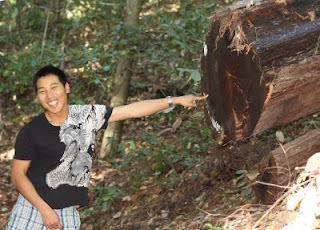Grey card/palm Technique
===================
- Calibrate first, comparing the meter reading of the grey card v.s inner palm. See how much the exposure reading difference is. Remember this difference delta and use that delta for everytime from now on.
- Before taking a pic, go close to the subject. Read the meter off my inner palm. Adjust it to + 1 stop Exposure bias or whatever the golden delta is from calibration above.
- keep that setting, go back to the taking palce, recompose, and shoot. Don't meter off or adjust the exposure again once we step back to recompose!!

- Normal procedure w/o Palm.
- Metered off the cheek, set EB=0 (since I know the color is close to skin and no direct sunlight, so guess that 0EB might be ok. But don't know for sure. But turned out fine luckily for first shot)
- pretty good exposure.
- NO grey card or hand necessary since the color is close to skin tone and there are no tricky snow or black in the whole pic.
- regular metering off works.

- Put the hand as close as possible to the cheek, metered off the palm, set EB= +2/3
- not as good exposure. Darker. The normal one above has better exposure.

- Normal metering off the dark red point, adjust to get EB = 0
- pretty good exposure since there is no tricky colors in the whole pic

- metered off the palm which is placed next to the dark red point.
- set EB = +2/3
- too dark. Normal procedure above was better
If there are no tricky colors (dark or snow) in the overall image, normal procedure of metering off the object and setting EB~0 is fine. Better than palm method.
Let's test for tricky colors.

- metered off this white laptop. Since I know I should set positive EB for white objects, adjust EB = +1
- Not bad. But tricky because I cannot always use +1EB for white. What if it's in the sun or what if it's whiter like snow? I only know I should set some + EB, but dunno how much exactly. Can do trial and error, but using palm might help this time

- metered off the palm placed next the the white region. set EB = +2/3 ("golden delta")
- better than normal procedure above
- palm reading (aka grey card) helps tricky exposures
Let's test for another tricky exposure (aka black object)

- want to expose the black obj correctly
- first hand, exposed off the black and adjust for EB~-1 (since I know that I need -EB to have dark things dark , and +EB to get white things white)
- too over-exposed
- after seeing that -1EB is not enough, can take another one with -2EB to get the dark darker. THis is 'trial and error' with guesstimate. Let's use the palm/grey card.

- metering off the palm placed on the dark obj
- better exp than normal procedure
- and no need to guesstimate EB bias or trial and error
Conclusion
--------------
- grey card (aka palm method) helps for tricky exposures (snow or dark objects)
- for normal tones with nice lighting (in my room) , it's not necessary. Normal intuition with some intuitive adjustment to exposure bias in the head is good enough. We definitely need to think about that intuitive adjustment though. Can't always set EB=0. That's where grey cards are handy. Just use grey card or palm and set it to EB= 0 for grey card or EB= golden delta for palm. No need to calculate/guesstimate in the head for EB adjustments.
- If we are in the sun with lots of contrast, and direct sunlight, guesstimate needs too many trial and error.
- should I set palm offset to something other than +2/3 EB? Since all pics with my palm are too dark. Maybe I should set it to +1 EB











